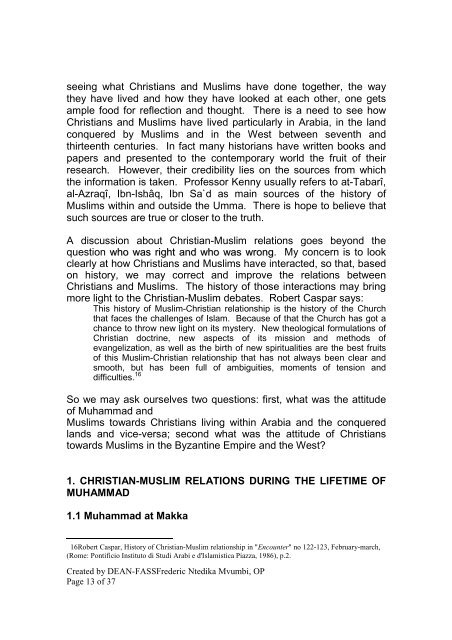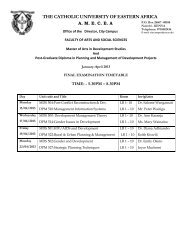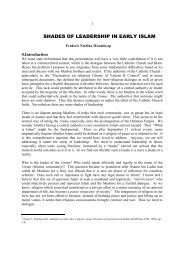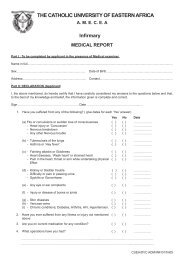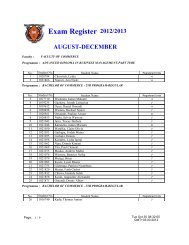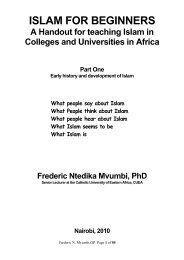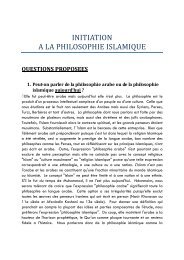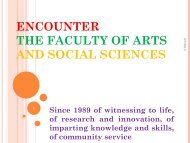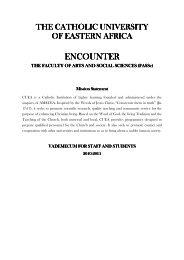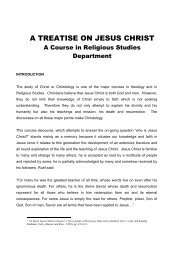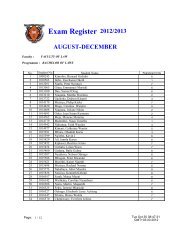PRINCIPLES FOR INTERRELIGIOUS DIALOGUE.pdf - CUEA
PRINCIPLES FOR INTERRELIGIOUS DIALOGUE.pdf - CUEA
PRINCIPLES FOR INTERRELIGIOUS DIALOGUE.pdf - CUEA
You also want an ePaper? Increase the reach of your titles
YUMPU automatically turns print PDFs into web optimized ePapers that Google loves.
seeing what Christians and Muslims have done together, the way<br />
they have lived and how they have looked at each other, one gets<br />
ample food for reflection and thought. There is a need to see how<br />
Christians and Muslims have lived particularly in Arabia, in the land<br />
conquered by Muslims and in the West between seventh and<br />
thirteenth centuries. In fact many historians have written books and<br />
papers and presented to the contemporary world the fruit of their<br />
research. However, their credibility lies on the sources from which<br />
the information is taken. Professor Kenny usually refers to a.t- .Tabarî,<br />
al-Azraqî, Ibn-Is .hâq, Ibn Sa`d as main sources of the history of<br />
Muslims within and outside the Umma. There is hope to believe that<br />
such sources are true or closer to the truth.<br />
A discussion about Christian-Muslim relations goes beyond the<br />
question who was right and who was wrong. My concern is to look<br />
clearly at how Christians and Muslims have interacted, so that, based<br />
on history, we may correct and improve the relations between<br />
Christians and Muslims. The history of those interactions may bring<br />
more light to the Christian-Muslim debates. Robert Caspar says:<br />
This history of Muslim-Christian relationship is the history of the Church<br />
that faces the challenges of Islam. Because of that the Church has got a<br />
chance to throw new light on its mystery. New theological formulations of<br />
Christian doctrine, new aspects of its mission and methods of<br />
evangelization, as well as the birth of new spiritualities are the best fruits<br />
of this Muslim-Christian relationship that has not always been clear and<br />
smooth, but has been full of ambiguities, moments of tension and<br />
difficulties. 16<br />
So we may ask ourselves two questions: first, what was the attitude<br />
of Muhammad and<br />
Muslims towards Christians living within Arabia and the conquered<br />
lands and vice-versa; second what was the attitude of Christians<br />
towards Muslims in the Byzantine Empire and the West?<br />
1. CHRISTIAN-MUSLIM RELATIONS DURING THE LIFETIME OF<br />
MUHAMMAD<br />
1.1 Muhammad at Makka<br />
16Robert Caspar, History of Christian-Muslim relationship in "Encounter" no 122-123, February-march,<br />
(Rome: Pontificio Instituto di Studi Arabi e d'Islamistica Piazza, 1986), p.2.<br />
Created by DEAN-FASSFrederic Ntedika Mvumbi, OP<br />
Page 13 of 37


